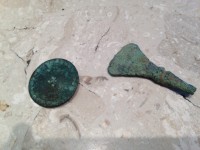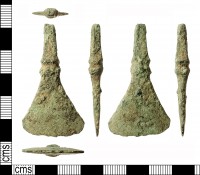 When Oxfordshire couple Christopher and June Preece vacationed last month on the Isle of Wight, they didn’t just bring sandals and sunscreen with them. Christopher packed his trusty metal detector too, so he and his beloved could take romantic walks on the beach sweeping the sand, yearning for a sweet serenade of loud beeps. The dream came true when they found a few metal artifacts under a slab of clay as they explored Sandown Beach: one wedge-shaped blade and one round token.
When Oxfordshire couple Christopher and June Preece vacationed last month on the Isle of Wight, they didn’t just bring sandals and sunscreen with them. Christopher packed his trusty metal detector too, so he and his beloved could take romantic walks on the beach sweeping the sand, yearning for a sweet serenade of loud beeps. The dream came true when they found a few metal artifacts under a slab of clay as they explored Sandown Beach: one wedge-shaped blade and one round token.
Chris said: “We love searching for items with our metal detectors and were walking on Sandown Beach when it buzzed and we noticed that the objects looked unusual.
“I have a keen interest in history and immediately thought they were very old, because the knife has a green colour which is often found on old copper. The shape also gave me an indication it was an historical artefact.
“We decided to take it to the visitor centre in Newport so that it could be passed on and identified.”
 The staff at the visitor centre in the Newport Guildhall called the local finds liaison officer, Frank Basford, to examine the objects. He found that the blade was late Bronze Age knife made of copper alloy. It is incomplete and the break is very old so it’s probably been this way a long time. The tang, collars and blade survive identifying it as a chisel-like implement that was used to work leather. Just two inches long from curved cutting edge to the tapered end of the tang and weighing half an ounce, the tool’s small size was practical for the crafting of leather; it wouldn’t have made much of a weapon or chopping blade. It’s a rare piece, but others of similar design have been found before. The style dates it to around 1,000-800 B.C.
The staff at the visitor centre in the Newport Guildhall called the local finds liaison officer, Frank Basford, to examine the objects. He found that the blade was late Bronze Age knife made of copper alloy. It is incomplete and the break is very old so it’s probably been this way a long time. The tang, collars and blade survive identifying it as a chisel-like implement that was used to work leather. Just two inches long from curved cutting edge to the tapered end of the tang and weighing half an ounce, the tool’s small size was practical for the crafting of leather; it wouldn’t have made much of a weapon or chopping blade. It’s a rare piece, but others of similar design have been found before. The style dates it to around 1,000-800 B.C.
 The metal button is also made of copper alloy. It was made in one piece with an integral drilled shank (most of which is now missing leaving just the stub behind) that would have been sewn to the garment. The front of the button is stamped or punched with a border of small circles. Inside each circle are incised patterns of parallel lines. In the center of the button is a saltire (a diagonal cross) with a little circle nestled in each angle. This piece too was dated from its style. Other buttons of this type date to the 17th century, so it’s likely this one does too. It is 1.2 inches in diameter, which means the 17th century button is more than half the width of the Bronze Age blade.
The metal button is also made of copper alloy. It was made in one piece with an integral drilled shank (most of which is now missing leaving just the stub behind) that would have been sewn to the garment. The front of the button is stamped or punched with a border of small circles. Inside each circle are incised patterns of parallel lines. In the center of the button is a saltire (a diagonal cross) with a little circle nestled in each angle. This piece too was dated from its style. Other buttons of this type date to the 17th century, so it’s likely this one does too. It is 1.2 inches in diameter, which means the 17th century button is more than half the width of the Bronze Age blade.
Because they’re made of copper alloy rather than gold or silver, it’s likely neither piece would have met the threshold to be declared official treasure at a coroner’s inquest. That means the finders would get to keep the artifacts instead of the Crown claiming them and giving a local museum the chance to acquire the pieces in exchange for a reward to be paid to the finders in the amount of the fair market value of the artifacts. The finders are avid history buffs, however, so they forewent the whole rigmarole and just straight donated the blade and button to the Newport Roman Villa museum.
June added:
“To be told the knife is several thousand years old is just incredible. We never thought what we found was so old.
“As it was found on the Island, we are very keen for residents and visitors to enjoy it and were happy to donate it to the council’s museum’s service so it can go on display.”
:love:
The imaging for the “Bronze Age knife found on Isle of Wight” with dimensions and all views as shown is a very professional and informative way of illustrating objects. Often there is little notations about the size and ALL views are not shown. BRAVO!
Curious that items from such different eras ended up in such close proximity.
I wondered about the same thing as Cordate… Although I suppose a beach is the kind of place where items which were lost at sea or in no dried out creeks might end up over time.
Got to love the attitude of the finders though. I hope they will go on to have many more interesting metal detecting finds!